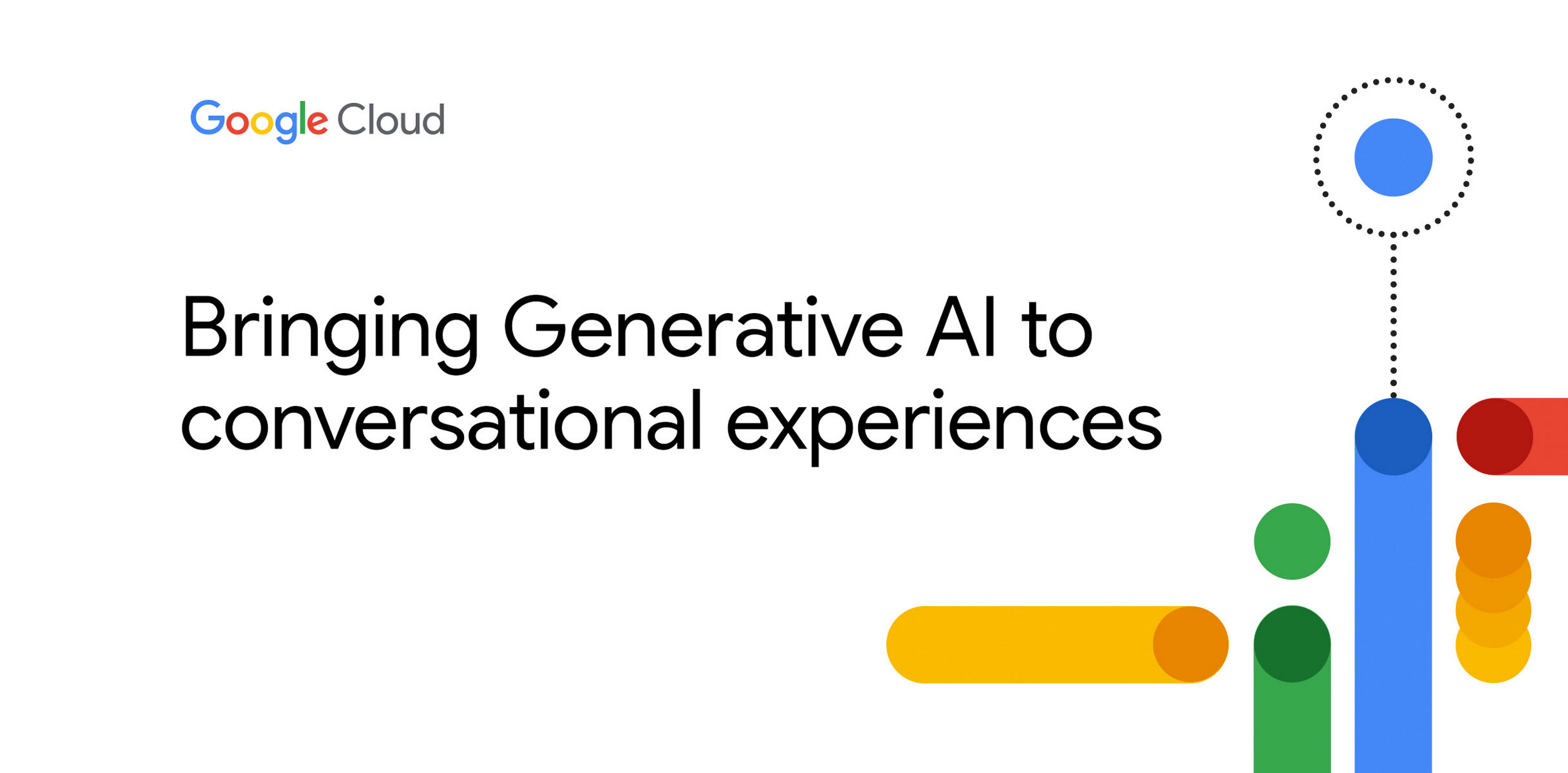Enterprise search apps and conversational chatbots are among the most widely-applicable generative AI use cases. With Generative AI App Builder (Gen App Builder), our goal has been to combine these capabilities into a single developer-friendly product that provides access to sophisticated foundation models, removes the complexity of grounding them in proprietary data, streamlines their implementation into apps, and provides enterprise-ready reliability, auditability, security, and data governance.
Today, we’re excited to announce that Conversational AI on Gen App Builder is generally available (GA) for allowlisted customers, or those approved for access via a request to their Google Cloud sales representatives.
Following last month’s GA launch of Enterprise Search on Gen App Builder, today’s news makes it easy for developers — even those without ML experience — to build AI-powered chatbots and conversational experiences covering customer and employee support; concierge assistance (e.g. personalized product discovery, travel planning, banking); automation of tasks (e.g., food ordering, appointment booking, e-commerce); device control (e.g. conversational manuals, in-car assistant); and more. With Conversational AI on Gen App Builder, allowlisted customers can:
-
Use the generative AI agent capability to build natural-sounding, human-like chat- and voice-bots that can answer questions accurately. To get started, organizations can simply point to their own data, including their websites, Q&A lists, manuals, an entire domain, or any other document on the web or safely stored by the organization in Google Cloud. With user-friendly tools, including no code setup, Conversational AI on Gen App Builder lets organizations accomplish in hours or days what used to take months—all with much higher quality.
-
Configure AI agents’ outputs to include citations or automatically load web pages that are contextually relevant to the conversation, such as surfacing a product page after a customer asks about a certain item.
-
Generators let customers easily use foundation models, giving them full control over the prompts, including the ability to include dynamic information based on the conversation so far or the agent’s state. Customers can use this capability to generate content, create summaries, perform complex NLU processing, chain multiple LLM calls, and more.
-
Generative Fallbacks let apps gracefully handle scenarios where there is no match to the user’s intent, using full generative outputs to provide personalized, empathetic outputs even when the question involves topics outside the company’s site or data.
These new capabilities are fully integrated with Dialogflow so customers can add them to their existing agents, mixing fully deterministic and generative capabilities.
In addition to the new generative capabilities, we have also added prebuilt components to reduce the time and effort required to deploy common conversational AI tasks and vertical-specific use cases. These components provide out-of-the-box templates for virtual agents and integrations, including much-requested features for collecting Numerical and Credit Card CVV inputs. The first set has been released in GA, with many more to come in 2023.
We’ve been pleased to see the innovative results our customers have already achieved with pre-GA releases of Gen App Builder. For example, Orange France recently launched Orange Bot, a French-language generative AI-enabled chatbot. Embedded on their website, it uses the company’s support knowledge to independently generate precise and immediate responses to customer questions and serve as a conversational search engine and entry point to their “help and contact” website. The chatbot stems from a long-term business vision to transform the customer relationship, optimize management costs, and offer ever more helpful and user-friendly experiences.
”With Gen App Builder, we were able to bring Orange Bot from ideation to production in only three weeks,” said Médéric Chomel, VP Data, AI & Automation at Orange France. “We can now quickly and accurately provide the information our customers are looking for, whether it is to know how to enable a SIM card, change a billing address, or manage parental control on Orange TV. Orange Bot will also serve as a conversational search engine and entry point to our ‘help and contact’ page. We expect to be able to manage 15 million interactions per year from the start.”
With these capabilities, developers can focus on designing experiences and deploying generative apps fast, without the delays and distractions of implementation minutiae. In this blog post, we’ll explore how your organization can leverage Conversational AI on Gen App Builder to create compelling, AI-powered experiences.
Visualizing the next generation of conversational apps
Chatbots have existed for years, so let’s start by walking through the below video to visualize how generative AI changes the game. With Conversational AI on Gen App Builder, organizations can orchestrate interactions, keeping users on task and productive while also enabling free-flowing conversation that lets them redirect the topic as needed.
Suppose a shopper looking for a new phone visits a website that includes a chat assistant. The shopper begins by telling the assistant they’d like to upgrade to a new Google phone.
Immediately, the site navigates to relevant content, such as a page of trade-in options, while the assistant suggests the shopper might be interested in Pixel Fold, Pixel 7, or Pixel 7 Pro, noting these are the most recent Google smartphones. Intrigued, the shopper asks which of these phones is available in white, prompting the assistant to answer that both the Pixel 7 and Pixel 7 Pro are available in a color called “snow.”

As the user asks questions, text auto-complete helps shape queries towards high-quality results. For example, if the user starts to type “How does the 7 Pro compare,” the assistant might suggest, “How does the 7 Pro compare to my current device?” If the shopper accepts this suggestion, the assistant can generate a multimodal comparison table, complete with images and a brief summary.
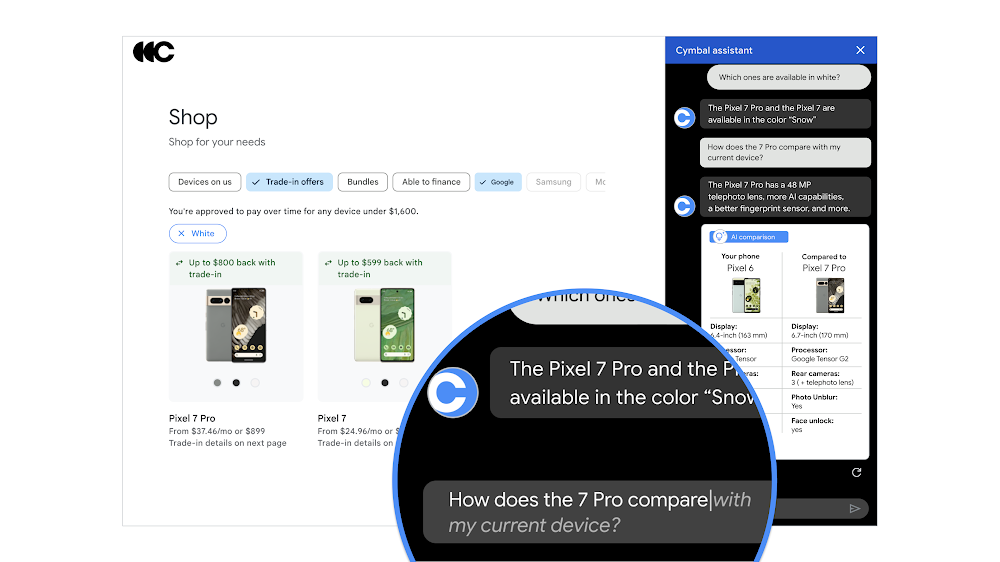
Let’s assume the user wants to drill into the comparison, which notes that unlike the user’s current device, the Pixel 7 Pro includes a 48 megapixel camera with a telephoto lens. The shopper asks “what is a telephoto lens?”, triggering the assistant to explain that this term refers to a lens that’s typically greater than 70mm in focal length, ideal for magnifying distant objects, and generally used for wildlife, sports, and portraits.
Whereas the assistant generated earlier answers from the website’s content, in the case of the lens question, the response involves information that’s not contained in the organization’s site. Gen App Builder lets organizations choose whether to surface only answers grounded in company data or, when one can’t be found there, to allow answers from the underlying model’s general knowledge and outside sources, as is the case in this example. This flexibility allows for a better experience than the “Sorry, I can’t answer that” responses we have come to expect from bots. When applicable, these types of responses include citations so the user knows what source content was used to generate the answer.
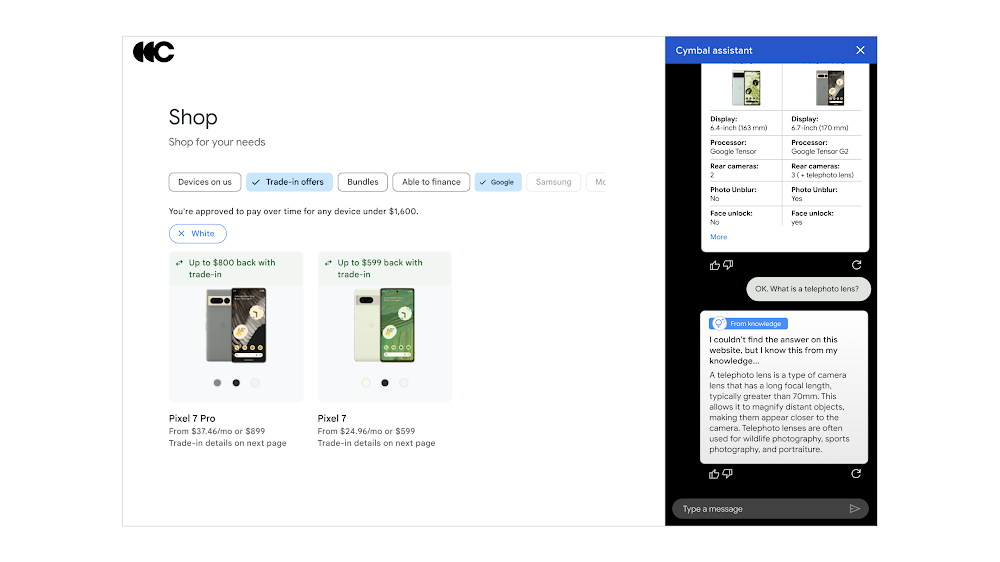
Satisfied that the Pixel 7 Pro is a compelling upgrade, the shopper next asks about the trade-in value of their current device. Switching back to responses grounded in the website content, the assistant answers with interactive visual inputs to help the user assess how the condition of their current phone could influence trade-in value.
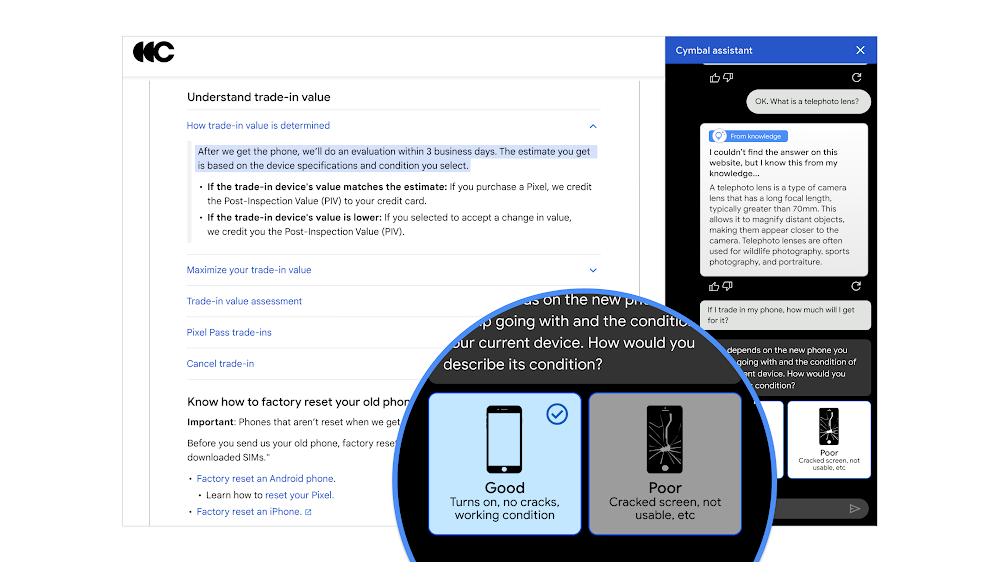
After answering a question about return policies, the assistant recognizes the shopper may be ready for a purchase and asks if it should generate a shopping cart. The user confirms, and the site immediately navigates to a checkout process. The assistant then asks if the shopper needs anything else, with the user replying that they’re interested in switching to a business account. This answer triggers the assistant to loop a human agent into the conversation, showcasing how prescribed paths can be seamlessly integrated into a primarily generative experience.
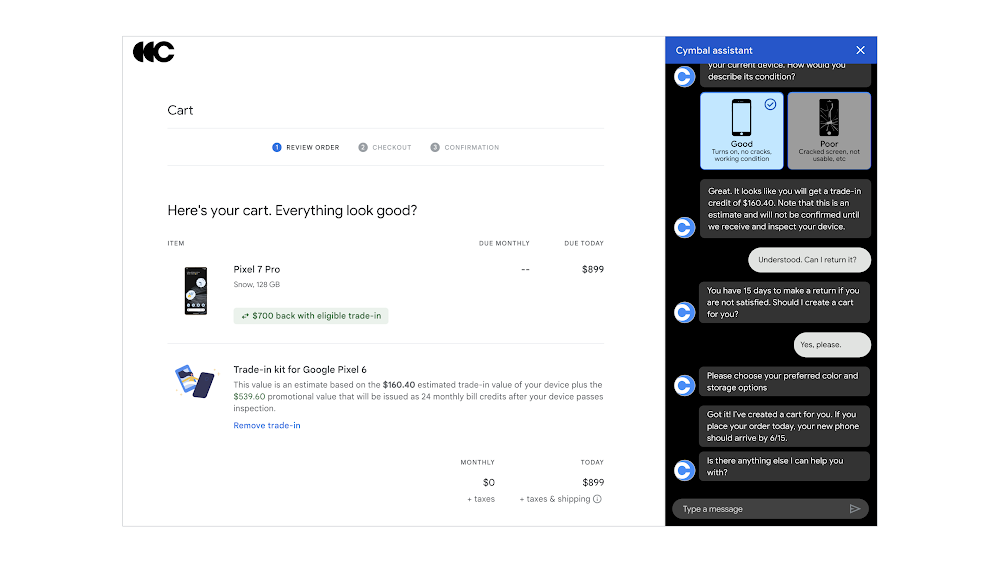
After the transfer, the shopper isn’t burdened by needing to get the human up to speed. Gen App Builder includes Agent Assist functionality, which summarizes previous interactions and suggests responses as the shopper continues to ask questions. As a result, the handoff from the AI assistant to the human agent is smooth, and the shopper is able to complete their purchase, having had their concerns efficiently answered.
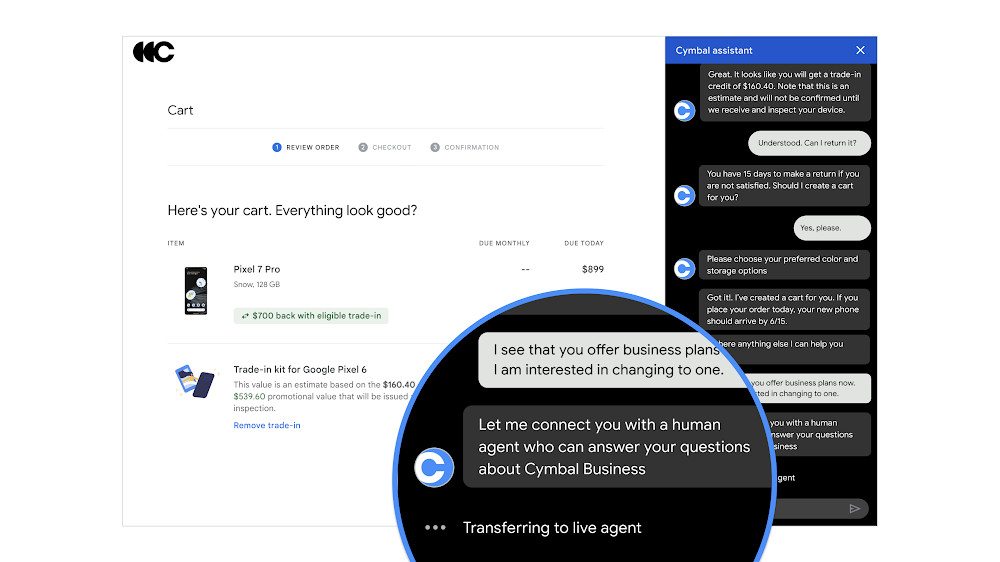
From start to finish, the experience offers the customer human-like interactions, low-friction paths to information and actions, and flexibility to redirect the conversation as needed—all capabilities far beyond those of previous-generation chatbots.
Building chatbots and virtual agents with Gen App Builder
As the previous example demonstrates, Gen App Builder can use both deterministic, intent-based processes (like following a pre-designed conversational flow by matching a user’s statement to a predefined intent) as well as generative processes to expand the coverage of the conversation (like addressing questions about the phone’s camera, generating a comparison table, etc.).
Generative AI App Builder’s step-by-step conversation orchestration includes several ways to add these types of task flows to a bot. For example, organizations can use prebuilt flows to cover common tasks like authentication, checking an order status, and more. Developers can add these onto a canvas with a single click and complete a basic form to enable them. Developers can also visually map out business logic and include the prebuilt and custom tasks. The graph is simple as the AI handles guiding the user conversation.
Support for English is now GA with allowlist, and support for several additional languages is available in preview: Danish, Dutch, French, German, Hindi, Italian, Brazilian Portuguese, Spanish, and Swedish.
We are also continuing to add new features to Enterprise Search on Gen App Builder with multimodal image search now available in preview. With multimodal search, customers can find relevant images by searching via a combination of text and/or image inputs. Between Gen App Builder’s Enterprise Search and Conversational AI capabilities, organizations have an increasingly robust and streamlined path to common generative AI use cases, and we’re excited to see these use cases provide value for our customers.
Start the conversation
Whether setting up chatbots in just a few steps or creating deep customizations and conversation flows, Conversational AI on Gen App Builder provides tools for developers at every level of machine learning expertise, making it easy for your business to create richer experiences for both employees and customers. To get started, read more about Gen App Builder and conversational AI technologies from Google Cloud, and reach out to your sales representative for access to conversational AI on Gen App Builder.

